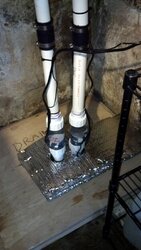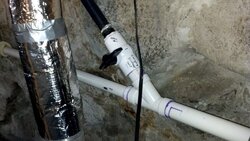Ok, so we have a 200 year old stone foundation with a poured concrete floor, and a high water table. This equals water every spring. there are drain tiles underfloor and a perimeter dran channel feeding a corner concrete sump pit. The pit used to gravity drain across the street and down a hilll, but the easement to do so got revoked a couple decades ago and in place we have a pump.
When I bought the place the pump was a 1/3hp pedestal pump, piped into a 1 1/4 PVC discharge, 1/14 check valve, about 4 ft up, 90 elbow and then across the cellar and through the wall. the 1 1/4 PVC runs underground across the lawn (about 40ft) and dumps into the storm drain. Not a great system, in really bad springs like 2010 it gets overwhelmed and I had to setup a second pump. And its very noisy right below the bedrooms.
So this year I set about really updating it properly.
#1 - I installed an AC/DC battery backup pump
#2 - I'm going to replace the old 1/3 pedestal with a Zoeller N53 submersible pump
#3 - try to improve the discharge plumbing (see question below)
#3 is the subject of this post. The discharge line to the street is 1.25 so I'm limited to that capacity, though the Zoeller is made for 1.5 and can probably push more flow if I reduce the restrictions a bit. So I have some ideas.
First, I'm going to plumb the Zoeller first into 1.5, take that vertical though a Zoeller 1.5in silent check valve, then a 1.5 90 elbow, and a length of straight 1.5 and then bush it down to the 1.25 outlet line. I figure that way Ive reduced the restriction of the check valve and elbow a bit, even if I still have the restriction of the rest of the line.
Next, I had an idea - I could run an emergency second discharge line out through the sill. Put a wye into the main discharge line before the reduction from 1.5 to 1.25, and hook up the emergency line to this wye via a ball valve. Normally it would stay closed, but If I have a real bad water intrusion and both pumps start running simultaneously but still cant keep up I can open the valve to give the water an additional exit path. Also might come in hand if the buried line ever froze (has never happpened so far, its downhill all the way - but who knows?)
So the question for all the plumbing experts - Any issue with using a wye in the line backwards like this to divert flow?

When I bought the place the pump was a 1/3hp pedestal pump, piped into a 1 1/4 PVC discharge, 1/14 check valve, about 4 ft up, 90 elbow and then across the cellar and through the wall. the 1 1/4 PVC runs underground across the lawn (about 40ft) and dumps into the storm drain. Not a great system, in really bad springs like 2010 it gets overwhelmed and I had to setup a second pump. And its very noisy right below the bedrooms.
So this year I set about really updating it properly.
#1 - I installed an AC/DC battery backup pump
#2 - I'm going to replace the old 1/3 pedestal with a Zoeller N53 submersible pump
#3 - try to improve the discharge plumbing (see question below)
#3 is the subject of this post. The discharge line to the street is 1.25 so I'm limited to that capacity, though the Zoeller is made for 1.5 and can probably push more flow if I reduce the restrictions a bit. So I have some ideas.
First, I'm going to plumb the Zoeller first into 1.5, take that vertical though a Zoeller 1.5in silent check valve, then a 1.5 90 elbow, and a length of straight 1.5 and then bush it down to the 1.25 outlet line. I figure that way Ive reduced the restriction of the check valve and elbow a bit, even if I still have the restriction of the rest of the line.
Next, I had an idea - I could run an emergency second discharge line out through the sill. Put a wye into the main discharge line before the reduction from 1.5 to 1.25, and hook up the emergency line to this wye via a ball valve. Normally it would stay closed, but If I have a real bad water intrusion and both pumps start running simultaneously but still cant keep up I can open the valve to give the water an additional exit path. Also might come in hand if the buried line ever froze (has never happpened so far, its downhill all the way - but who knows?)
So the question for all the plumbing experts - Any issue with using a wye in the line backwards like this to divert flow?





